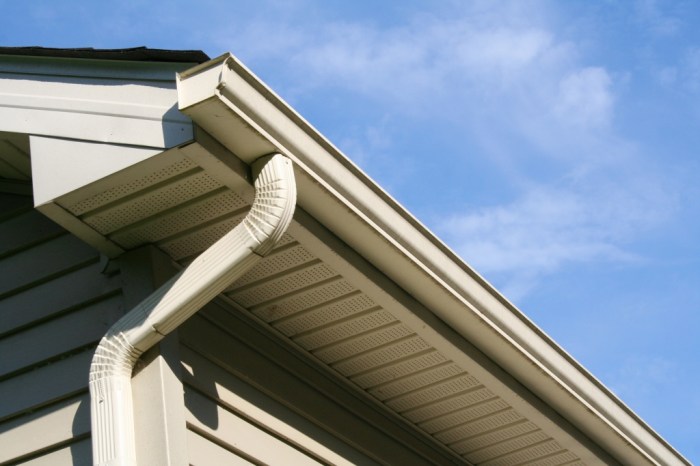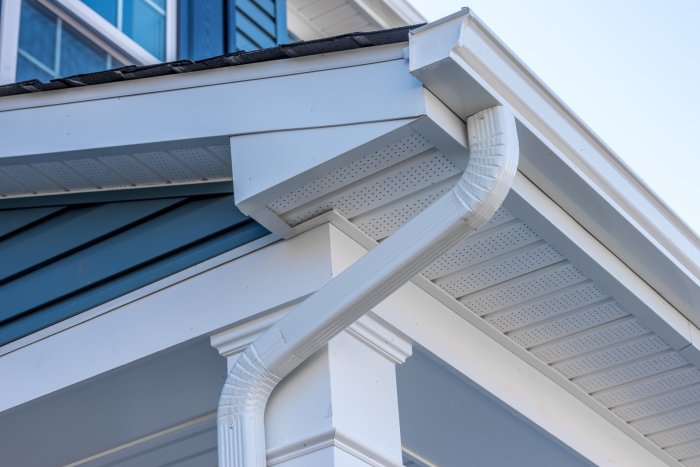Exploring the World of Siding and Gutters
Embark on a journey through the realm of siding and gutters, where we unravel the intricacies of these essential components of a home. From the diverse range of siding materials to the importance of efficient gutter systems, this exploration promises to be enlightening and engaging.
Delve deeper into the nuances of siding installation and gutter maintenance as we navigate through the ins and outs of these vital aspects of home improvement.
Siding Materials

When it comes to siding materials, there are several options available in the market, each with its own set of advantages and disadvantages. Let's take a closer look at some of the most commonly used siding materials, including vinyl, wood, fiber cement, and metal.
Vinyl Siding
Vinyl siding is a popular choice for homeowners due to its affordability and low maintenance requirements. It comes in a wide range of colors and textures, making it easy to find a style that suits your home's aesthetic. However, vinyl siding may not be as durable as other materials and can crack or fade over time.
Wood Siding
Wood siding offers a natural and timeless look that many homeowners appreciate. It can be painted or stained in various colors to match your preferences. While wood siding is environmentally friendly and biodegradable, it requires more maintenance than other materials and is susceptible to rot and insect damage.
Fiber Cement Siding
Fiber cement siding is a durable and long-lasting option that mimics the look of wood without the maintenance issues. It is resistant to fire, rot, and pests, making it a practical choice for many homeowners. However, fiber cement siding can be more expensive than other materials and may require professional installation.
Metal Siding
Metal siding, such as aluminum or steel, is known for its strength and longevity. It is resistant to fire, rot, and insects, making it a low-maintenance option for homeowners. Metal siding is available in a variety of colors and finishes, but it can dent or scratch easily if not properly maintained.Overall, the choice of siding material will depend on your budget, maintenance preferences, and desired aesthetic.
Consider the pros and cons of each material carefully before making a decision for your home.
Gutter Systems
Having a proper gutter system is crucial for maintaining a home and protecting it from water damage. Gutters help to direct rainwater away from the foundation of the house, preventing erosion, leaks, and other potential issues.
There are several types of gutter systems available, each with its own unique features and benefits. The most common types include K-style gutters, half-round gutters, and box gutters.
Types of Gutter Systems
- K-Style Gutters:These gutters have a flat bottom and back, with a decorative front that resembles the letter K. They are popular due to their capacity to hold a large amount of water and their sleek appearance.
- Half-Round Gutters:As the name suggests, these gutters are half-round in shape and offer a more traditional look. They are often chosen for their aesthetic appeal and ability to handle heavy rainfall effectively.
- Box Gutters:Box gutters are built into the roof structure, making them less visible from the ground. They are commonly used in commercial buildings but can also be found in some residential properties.
Installation and Maintenance of Gutters
Proper installation and regular maintenance are essential for ensuring the optimal functionality of gutter systems. During installation, it is important to ensure that the gutters are sloped correctly to allow water to flow towards the downspouts.
Maintenance tasks may include cleaning out debris, checking for leaks or damage, and ensuring that the downspouts are clear of any obstructions. Regular inspections can help prevent issues such as clogs and overflowing gutters, which can lead to water damage.
Siding Installation
Installing siding on a residential property involves several steps that are crucial to ensure a successful outcome. Proper preparation of the exterior surface is essential to avoid issues in the future. Let's delve into the details of siding installation.
Steps for Siding Installation
- 1. Remove old siding: Start by removing any existing siding to create a clean surface for the new siding installation.
- 2. Inspect and repair the exterior: Check for any damage or rot on the exterior surface of the property. Make necessary repairs before proceeding.
- 3. Install insulation: Add insulation to improve energy efficiency and provide a barrier against moisture.
- 4. Measure and cut siding: Accurately measure and cut the siding panels to fit the dimensions of the property.
- 5. Attach siding: Secure the siding panels to the exterior surface using the appropriate fasteners.
- 6. Finish edges and corners: Pay attention to finishing the edges and corners properly for a polished look.
Preparing the Exterior Surface
- 1. Clean the surface: Remove dirt, debris, and any mold or mildew from the exterior surface before starting the installation.
- 2. Repair any damage: Fill in cracks, holes, or any damaged areas on the surface to ensure a smooth application of siding.
- 3. Apply a weather-resistant barrier: Install a weather-resistant barrier to protect the property from moisture and water infiltration.
- 4. Check for levelness: Ensure the surface is level and flat to prevent any issues with the siding installation.
Common Challenges and Solutions
- 1. Warping or buckling of siding panels: To prevent this, ensure proper installation techniques and use quality materials.
- 2. Water damage: Properly seal seams and edges to prevent water infiltration behind the siding.
- 3. Incorrect measurements: Double-check all measurements before cutting siding panels to avoid costly mistakes.
- 4. Inadequate insulation: Proper insulation is essential for energy efficiency and preventing moisture issues.
Gutter Maintenance

Regular maintenance of gutters is crucial in preventing water damage to your home. By keeping your gutters clean and in good condition, you can avoid issues like leaks, clogs, and damage that can lead to costly repairs. Here is a guide on how to effectively and safely maintain your gutters:
Cleaning Gutters
To clean your gutters effectively, follow these steps:
- Start by using a sturdy ladder to access your gutters safely.
- Remove leaves, twigs, and debris by hand or with a small garden trowel.
- Flush out remaining dirt and debris with a garden hose, starting from the end opposite the downspout.
- Check for any clogs in the downspouts and clear them using a plumber's snake or pressure washer.
- Inspect the gutters for any signs of damage or leaks while cleaning.
Inspecting Gutters
Regularly inspect your gutters for leaks, clogs, and damage by following these tips:
- Look for water stains on the exterior walls, which can indicate a leak.
- Check for sagging or misaligned gutters, which may need to be repositioned or repaired.
- Ensure that the gutters are securely attached to the fascia board and not pulling away.
- Inspect the seams and joints for any signs of separation or damage.
- Clear any debris from the gutters and downspouts to prevent clogs.
Repairing Gutters
If you notice any issues while inspecting your gutters, take action to repair them promptly:
- Seal any leaks or holes with gutter sealant or silicone caulk.
- Replace damaged sections of gutters or downspouts to ensure proper drainage.
- Reposition or secure loose gutters to prevent further damage.
- Consider installing gutter guards to reduce the frequency of cleaning and maintenance.
Final Conclusion
As we conclude our exploration of siding and gutters, we reflect on the key takeaways and insights gained. From the significance of regular maintenance to the challenges of installation, this discussion serves as a comprehensive guide for homeowners looking to enhance their property.
User Queries
What are the benefits of vinyl siding?
Vinyl siding is cost-effective, low maintenance, and versatile in terms of colors and styles, making it a popular choice among homeowners.
How often should gutters be cleaned?
Gutters should ideally be cleaned twice a year to prevent clogs and water damage. However, frequency may vary depending on the surrounding environment.
What is the average lifespan of fiber cement siding?
Fiber cement siding can last up to 50 years with proper maintenance, making it a durable option for homes.
How can I identify gutter leaks?
Inspect gutters for water stains on the exterior walls, pooling water near the foundation, or rust spots, which can indicate leaks that need to be addressed.




